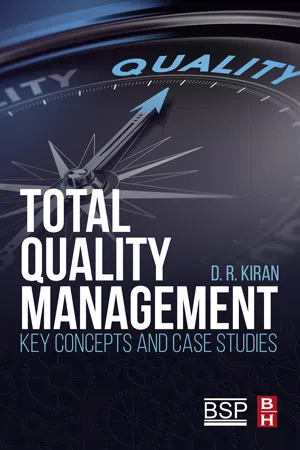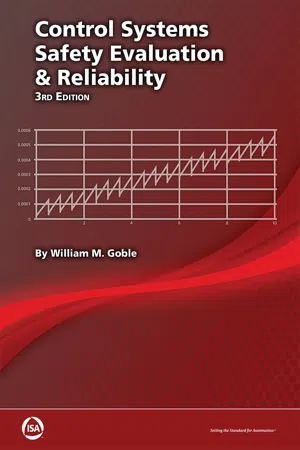Failure Mode and Effects Analysis
Failure Mode and Effects Analysis (FMEA) is a systematic method for identifying and evaluating potential failure modes in a process, product, or system, and their potential effects. It helps to prioritize and address the most critical failure modes to improve reliability and safety. FMEA is commonly used in engineering, manufacturing, and other industries to proactively manage risks and enhance product quality.
8 Key excerpts on "Failure Mode and Effects Analysis"
- eBook - ePub
Total Quality Management
Key Concepts and Case Studies
- D.R. Kiran(Author)
- 2016(Publication Date)
- Butterworth-Heinemann(Publisher)
...There are uncertainties at every stage, and the engineer is bound to make presumptions, either from data, books, or from his experience. These uncertainties can be in the form of: • models used for the design calculations, • performance characteristics of the materials, • inconsistencies in the materials purchased, • nature of the pressure the finished product will encounter, • size of the product, whether a medium-sized product or a large-sized product, • volume of production, viz, batch production or mass production, • specialized materials and skills used in the manufacture. Apart from the above, the engineer may also experience uncertainties from the viewpoint of several other variables in the development. 26.2 Failure Modes and Effects Analysis Failure Mode and Effects Analysis (FMEA) is one of the best management tools to analyze the potential failure modes within a system under conditions of uncertainties, as stated above. Its principle is quite basic, and has been practiced since the olden days as the trial and error method. But since learning from each failure is both costly and time-consuming, the modern form of FMEA was developed during the 1940s, as explained in the following section. It emphasizes the probability of occurrence of that failure, and the severity of its effect on the system of every uncertainty. It is used to identify potential failure modes, determine their effect on the operation of the product, and identify actions to mitigate the failures. It analyzes potential reliability problems early in the development cycle, where it is easier to take actions to overcome these issues, thereby, enhancing reliability through design. FMEA should always be done whenever failures would mean potential harm or injury to the user of the end item being designed. According to Besterfield et al., FMEA is a “before-the-event” action requiring a team effort to easily and inexpensively alleviate changes in design and production...
- eBook - ePub
- Nigel Hyatt(Author)
- 2018(Publication Date)
- CRC Press(Publisher)
...CHAPTER 9 Failure Mode and Effects Analysis What Is FMEA? FMEA is a Failure Mode and Effects Analysis tool that is used in various industries to Identify failures, Evaluate the effects of the failures, and Prioritize the failures according to severity of effects. Prioritization or risk ranking is done mainly using Risk Matrix (Risk Priority Number) Criticality Analysis (FMECA) Reasons for Using FMEA To identify specific accident situations To consider alternative safety improvements To obtain data for quantitative risk analysis (QRA) To evaluate hazards from preliminary designs and operating procedures To improve reliability of the process To meet regulatory requirements To document a systematic process hazard evaluation To evaluate complex processes where perceived risks are significant To identify single-point failures When and Where to Use It? Implementing it as soon as the preliminary designs are ready ensures that the necessary design changes can be made at the earliest possible time. Its usefulness lies in preventing failures from occurring in the future. So, it is usually done in the design phase when the failure modes have not yet been built-in to the process. A good FMEA is an ongoing process whereby it is continuously updated and revised over the life of the process. It is performed on Mechanical equipment such as pumps, compressors, etc...
- William Goble(Author)
- 2010(Publication Date)
- International Society of Automation(Publisher)
...5 FMEA / FMEDA Failure Modes and Effects Analysis (FMEA) and Failure Modes Effects and Diagnostic Analysis (FMEDA) are commonly used analysis techniques in the fields of reliability and safety engineering. Both techniques will be discussed in this chapter. Failure Modes and Effects Analysis A Failure Modes and Effects Analysis (FMEA) is a systematic technique that is designed to identify problems. It is a “bottom up” method that starts with a detailed list of all components within the analyzed system. A whole system can be analyzed one component at a time via a hierarchical structure. A component level FMEA done on a module will provide module level failure modes. Those failure modes from various modules can be used in the FMEA of a unit. The results of that analysis will provide unit level failure mode, which can be used at the system level. The sequence is not fixed. It is possible to start at the system level with defined units and postulated failure modes. The FMEA can be done on each grouping in the hierarchy as required by the goals of the analysis. The primary reference for the FMEA technique is MIL-STD-1629 (Ref. 1). FMEA Procedure The minimum steps required in the FMEA process (here, at the component level) are simple: A. List all components. B. For each component, list all known failure modes. C. For each component/failure mode, list the effect on the next higher level. D. For each component/failure mode, list the severity of effect. At a module or unit level, simply list the functional failure modes of that level. Often these modes will be identified by another lower level FMEA. A FMEA can be very effective in identifying potential critical failures within a device. One of the primary reasons for doing this is so that the design can be changed to eliminate critical failures. For this reason, the best possible time to do a FMEA is during the design phase of a project...
- eBook - ePub
Aircraft System Safety
Assessments for Initial Airworthiness Certification
- Duane Kritzinger(Author)
- 2016(Publication Date)
- Woodhead Publishing(Publisher)
...5 Failure Modes and Effects Analysis Abstract An Failure Modes and Effects Analysis (FMEA) is a systematic ‘bottom-up’ method of (1) identifying single failure modes and failure probabilities of a system, item, function, or piece-part (i.e. smallest individual part or component); (2) determining the effects of this failure mode on the next higher level of the design (if available to the assessor, i.e. an LRU supplier will not know how much redundancy the system integrator is going to build into his system); and (3) classifying failure modes according to the worst case severity of the end effect. Keywords Compensating provisions; Failure criticality; Failure detection method; Failure effect; Failure mode; FMEA; FMECA; Functional Block Diagram; Functional FMEA; Piece-part FMEA; Prioritise; Process FMEA Failure is the rule rather than the exception, and every failure contains information. Steve Wozniak (Apple co-founder) 5.1. Introduction In this chapter we explore the Failure Modes & Effects Analysis (FMEA) and the Failure Modes Effects & Criticality Analysis (FMECA) which, as the name suggests, simply is an extension of the FMEA. 1 This chapter will use the acronym FMEA and highlight those instances where is extended to include FMECA. 5.1.1. Background An FMEA is a systematic ‘ bottom-up ’ method of: • identifying single failure modes and failure probabilities of a system, item, function or piece-part (i.e. smallest individual part or component); • determining the effects of a failure mode on the next higher level of the design (if available to the assessor as an LRU supplier will not necessarily know how much redundancy the system integrator is going to build into his system); • classifying failure modes according to the worst case severity of the end effect (FMECA only). The FMEA approach has been around for a very long time...
- eBook - ePub
- Bijan Elahi(Author)
- 2018(Publication Date)
- Academic Press(Publisher)
...FMEA is a forward reasoning process, also referred to as bottom-up, or inductive analysis. The FMEA technique was originally developed by the US military in 1949 as a reliability analysis tool. Later, it was used by NASA in many space programs. Today, many industries, in particular the automotive industry, use this analytical tool to improve the quality of their products. There are different types of FMEA processes serving different purposes. The BXM method adapts the FMEA for the benefit of medical device risk management and uses four types of FMEA: Design Failure Modes and Effects Analysis (DFMEA), Software Failure Modes and Effects Analysis (SFMEA), Process Failure Modes and Effects Analysis (PFMEA) and Use-Misuse Failure Modes and Effects Analysis (UMFMEA). At the service risk management, FMEAs are to identify Hazards, and estimate the likelihood of their occurrence. It is important to distinguish two terms: Fault and Failure. A fault is an anomalous condition for a part. A failure is the inability of an entity to achieve its purpose. • A fault could result in a failure, but not necessarily • A failure may occur with no faults With respect to risk management, FMEAs are used to identify Failure Modes which can result in Hazards or Hazardous Situations. It is important to realize that occurrence of faults and failures can result in Hazards, but not necessarily. And Hazards or Hazardous Situations can occur in the absence of any fault/failure. To elucidate—a medical device that is designed for adults, if used on children may create a Hazardous Situation, even though the device is working perfectly according to its design. Or, a medical device may have a fault that doesn’t create a Hazard. In the FMEA, the subject of analysis is decomposed into elements. The granularity of this decomposition is subjective and is called the level of indenture. During the course of the analysis, the Failure Modes of each element and consequences on the subject of analysis is considered...
- eBook - ePub
The Handbook of Patient Safety Compliance
A Practical Guide for Health Care Organizations
- Fay A. Rozovsky, James R. Woods, Fay A. Rozovsky, James R. Woods(Authors)
- 2016(Publication Date)
- Jossey-Bass(Publisher)
...CHAPTER FOUR FAILURE MODES AND EFFECTS ANALYSIS : The Risks and the Rewards in Health Care Robert J. Latino Failure modes and effects analysis … what a complex sounding and intimidating name! Although the FMEA methodology has been around for decades, it is relatively new to the health care world. The very name itself, failure modes and effects analysis, suggests that engineers had a hand in its original development. Engineers, known for their left-brain tendencies, are stereotyped as logical individuals who plan and structure everything. Seen through an engineer’s eyes, the world is a complex system in which the known sciences must apply to solve all problems. Contrast this to what engineers are not characteristically known for—that is their right-brain tendencies or the ability to be creative and think in the abstract or in concepts (versus the definitiveness of known science). Herein lies the crossroads at which FMEA meets health care. Recent efforts by the Joint Commission on Accreditation of Healthcare Organizations (JCAHO) attempt to utilize FMEA and apply it to health care systems. This is an admirable effort and, this author believes, a well-founded one. However, the cultural differences between industry and health care must be taken into consideration and accounted for in order for this initiative to be successful. Traditional FMEA Roots Start with an understanding of the original intent of FMEA. It is a foundation for determining what modifications would be appropriate for FMEA in the health care environment. Consider that the FMEA technique was born in the aircraft industry, and FMEA is most widely known for its applicability to aircraft design. It has since been applied successfully to an array of equipment and systems issues in the continuous process and batch-processing industries...
- eBook - ePub
Reliability Culture
How Leaders Build Organizations that Create Reliable Products
- Adam P. Bahret(Author)
- 2021(Publication Date)
- Wiley(Publisher)
...Like anything else that is powerful, it's just as easy to cut off your own leg with it if you don't know what you are doing. Simply put, a badly run FMEA is something you would wish upon your competitors. It wastes time, drains morale, and doesn't provide any valuable program or design input. What more could you hope for for the other guy with a product next to yours on the store shelf? There are many flavors of FMEA. The three most common are Design (DFMEA), Process (PFMEA), and Use (UFMEA). Design Failure Mode Effects Analysis Risk analysis tools like Design Failure Mode Effects Analysis (DFMEA) are fundamental to understanding the greatest threats to the success of the product in the field. By identifying risk, resources can be allocated in a way that matches the need. Just assessing risk isn't valuable to an engineer. Everything has risk. Which items should I act on? What level of risk is too risky? A tool like a DFMEA can be of significant value to the team, as long as it is recategorized as being primarily a project management tool. The value to the engineer is that the entire multidisciplinary team is providing input (read “ownership”) into the risks in the design. By doing this there is an automatic resource, time, and money allocation to specific design parameters. Actions by the entire team associated with assessing and reducing this risk will be agreed upon. In no way did the exercise mitigate the risk. That's the designer's job. The designer wants the DFMEA so they have input, buy‐in, and do not have to campaign for time or money to spend “more” on developing the product. It is a critical tool in the designer’s process. With a DFMEA‐based risk analysis, a designer can ensure they are working on the right things at the right time. We need to constantly remind ourselves and our team what the intent of a DFMEA is during the process. It is simply a project management tool...
- Dr. Ali Jamnia(Author)
- 2018(Publication Date)
- CRC Press(Publisher)
...The first step of this process is to obtain failed samples from the servicing center(s). If possible, obtain the parts from the time periods when the negative trends were observed. Failed samples obtained from the service center(s) require testing to ensure that they did indeed fail and that the product performance metrics accurately reflect the fielded product. Once the failure has been confirmed, a failure analysis of the defective item(s) should be performed to establish the responsible failure mechanism. Failure Analysis and Root Cause Determination Once the failure has been confirmed, a failure analysis of the defective item(s) should be performed to establish the responsible failure mechanism. This can be done in a variety of ways; however, many engineers tend to focus on what they or their close teammates can (or cannot) do. Many opt to look for a solution in their own labs. This approach is practical when the same business has also manufactured the failed component or assembly. Otherwise, a very knowledgeable ally is the manufacturer because it has a more intimate knowledge of potential causes of failure modes. At times, performing a search of existing data to uncover similar failure occurrences in this or related items may provide a historical perspective of the observed failure mode/mechanism. Have these failure modes been evaluated and/or addressed before? Additionally, design, manufacturing, or service changes—either in process or tools—may have caused an increase in failure rates of the component and/or subsystem...







